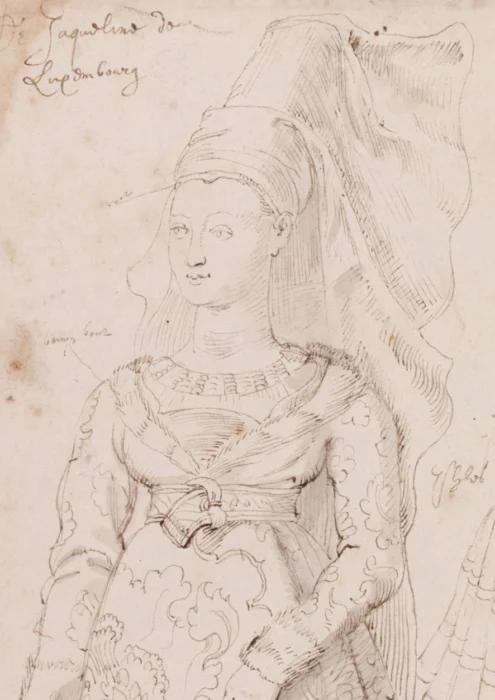בין חרבות, בריתות ודם שנשפך במאה ה־15, התקיימה גם זירה אחרת, זירה נשית. שם נולדה יריבות אכזרית בין שתי נשים שלא פחדו להיאבק על כוח והשפעה: ז'אקטה מלוקסמבורג ואלינור קובן.
בין כל הגברים שהחזיקו חרבות, אדמות ותארים במאה ה־15, התקיימה גם זירה נשית לא פחות עוצמתית. אחת מהיריבויות הבולטות באותן שנים הייתה בין ז’אקטה מלוקסמבורג, גבירת הנהרות, לבין אלינור קובן, אשתו של הדוכס המפורסם גלוסטר.
ג’ון, דוכס בדפורד – היה אחיו הבכור של הנרי החמישי, ובמותו הפך לעוצר באנגליה ובצרפת עבור אחיינו הקטין הנרי השישי. הוא היה איש ממסד, זהיר, וכמי שנשא את ז’אקטה מלוקסמבורג חיזק את קשרי בית לנקסטר עם בתי אצולה בצרפת.
המפרי, דוכס גלוסטר – אחיו הצעיר של בדפורד, נודע כאימפולסיבי ושאפתן. הוא לא הסתפק בתפקיד המשני שניתן לו באנגליה, אלא ביקש לעצב לעצמו תפקיד מוביל. נישואיו לאלינור קובן, אצילה כריזמטית, העצימו את כוחו הפוליטי.
המתח בין האחים
המשטר הלנקסטרי בראשית שלטונו של הנרי השישי עוצב למעשה על ידי שני דודיו: ג’ון, דוכס בדפורד, והמפרי, דוכס גלוסטר.
בדפורד היה איש ממסד זהיר, שניסה לשמר את הבריתות עם צרפת ובורגונדי ולנהל מדיניות אחראית. גלוסטר, לעומתו, היה שאפתן ואימפולסיבי, נמשך להרפתקאות צבאיות ולמהלכים אישיים שנשאו מחיר פוליטי כבד.
כבר בשנות ה־20 של המאה ה־15 גלוסטר לא היסס להאשים את אחיו בבגידה, והאשמותיו כמעט עלו לבדפורד במעמדו. רק בזכות התערבות ישירה של המלך הצעיר ותומכיו הצליח בדפורד לצאת מהסערה. המתח הזה לא היה שולי: הוא חתר תחת כל ניסיון ליציבות והפך את חצר לנקסטר לזירה טעונה ומסוכסכת.
כאן נכנסה גם אלינור קובן, רעייתו של גלוסטר. היא לא הסתפקה בתפקיד משני, אלא עודדה את בעלה לנקוט קו כוחני ובלתי מתפשר מול אחיו. נישואיהם, שהחלו כפרשה שערורייתית אחרי שהוא זנח את ז’קלין מהנאו, הפכו אותה לשותפה מלאה בשאיפותיו. השפעתה ניכרה היטב: קולות החצר תיארו אותה כתחמנית, יוקרתית ונחרצת, מי שחיזקה את גלוסטר מול בדפורד ושימשה לו חומת תמיכה פוליטית ורגשית גם כאשר התנהלותו סיכנה את האינטרסים של הכתר.
כך, לא מדובר רק במאבק בין שני אחים, אלא במשולש פוליטי שבו גם הנשים מילאו תפקיד: אלינור לצדו של גלוסטר, מול ז’אקטה שנשאה את דגלו של בדפורד.
היריבות הנשית כהשתקפות פוליטית
מכאן ניתן להבין כיצד נוצר מצב שבו שתי נשים, ז’אקטה ואלינור, מייצגות בעצם שני מחנות גבריים יריבים: האחד ממסדי וזהיר, האחר הרפתקני ושאפתני. היריבות האישית ביניהן נתפסה בחצר גם כהמשך ישיר ליריבות בין שני הדוכסים עצמם, ולכן קיבלה ממד פוליטי מובהק.
ז’אקטה נישאה לדוכס בדפורד, אחיו של המלך הנרי החמישי, והפכה במהרה לדמות אינטגרלית בחצר המלכות. היא שיקפה את המחנה הממסדי והאחראי, זה שניסה להבטיח יציבות במדינה שסועת מלחמות. אלינור קובן, לעומתה, עלתה לגדולה דרך נישואיה לגלוסטר, הדוד האימפולסיבי והשאפתני של המלך הנרי השישי. היא תפסה מקום מרכזי בחצרו והייתה ידועה כנחרצת, כוחנית ובעלת השפעה.
היריבות ביניהן לא הייתה רק עניין אישי של יוקרה נשית, אלא שיקפה את המאבק הפוליטי בין שני מוקדי כוח: בדפורד, שחתר למדיניות זהירה ויציבה, מול גלוסטר, שדחף להרפתקאות ולמהלכים עצמאיים. כך הפכה התחרות ביניהן לייצוג מובהק של הקרע בתוך חצר לנקסטר.
אלינור עצמה לא חיה בצל: בשנות ה־40 של המאה ה־15 היא נגררה למשפט סוער באשמת כישוף וניסיון לפגוע במלך הצעיר הנרי השישי באמצעות נבואות ולחשים. היא הושפלה בפומבי, נידונה לכליאה ואיבדה את מעמדה. שנים לאחר מכן גם ז’אקטה תואשם בכשפים, אך תזוכה. הדמיון הגורלי הזה ממחיש עד כמה נשים בחצרות שלטון נדרשו ללכת על חבל דק: מצד אחד מוקד כוח והשפעה, מצד שני יעד קל להאשמות של בגידה, חוסר נאמנות או כישוף.
היריבות בין שתי נשים לא נותרה פרט שוליים אלא הפכה למראה של הממלכה כולה: פוליטיקה, מגדר ותככים שנשזרו זה בזה, וכולם הכשירו את הקרקע לסערה הגדולה: מלחמות השושנים.


Sorcery, Rivalry, and Power Struggles: Jacquetta of Luxembourg vs. Eleanor Cobham
Amid the swords, alliances, and bloodshed of the fifteenth century, another battlefield emerged: the world of women. Here raged a fierce rivalry between two figures who dared to fight for power and influence.
One of the most striking rivalries of the era was between Jacquetta of Luxembourg, the “Lady of the Rivers,” and Eleanor Cobham, wife of the notorious Duke of Gloucester.
John, Duke of Bedford – The elder brother of Henry V, who became regent in England and France after the king’s death, ruling on behalf of his young nephew, Henry VI. Bedford was a cautious statesman, and his marriage to Jacquetta strengthened Lancaster’s ties with the French nobility.
Humphrey, Duke of Gloucester – The younger brother of Bedford, known for his impulsive and ambitious nature. Refusing to accept a secondary role in England, he sought to carve out a dominant position of his own. His marriage to Eleanor Cobham, a charismatic noblewoman, only magnified his political clout.
Tension Between the Brothers
The Lancastrian regime during Henry VI’s early reign was effectively shaped by his two uncles: Bedford and Gloucester.
Bedford embodied a cautious, institutional approach, aiming to preserve alliances with France and Burgundy. Gloucester, by contrast, leaned into reckless adventures and personal ambition, often at the cost of political stability.
By the 1420s, Gloucester did not hesitate to accuse his brother of treason charges that nearly ruined Bedford’s standing. Only the direct intervention of the young king and his allies allowed Bedford to escape unscathed. This tension was not peripheral but cut to the heart of Lancastrian politics, destabilizing the very foundations of the crown.
At Gloucester’s side stood Eleanor Cobham. She refused to be relegated to the background, urging her husband to pursue a hardline stance against Bedford. Their marriage, scandalous from the start after Gloucester abandoned Jacqueline of Hainault, made her a central partner in his political designs. Contemporary voices described Eleanor as cunning, ambitious, and uncompromising —a woman who emboldened Gloucester, even when his actions endangered the interests of the crown.
This was not merely a fraternal feud but a political triangle: Eleanor alongside Gloucester, Jacquetta alongside Bedford.
Female Rivalry as Political Mirror
The rivalry between Jacquetta and Eleanor was more than a clash of personalities; it reflected the fracture at the core of Lancastrian rule.
Jacquetta, as the wife of Bedford, symbolized the institutional, stabilizing faction of the court. Eleanor, by contrast, embodied Gloucester’s impulsive and confrontational camp. Their personal rivalry was interpreted at court as an extension of the brothers’ own feud, giving their contest political weight far beyond questions of female prestige.
Eleanor’s story grew darker: in the 1440s, she was tried for witchcraft, accused of plotting to harm the young Henry VI with spells and prophecies. Publicly disgraced, she was sentenced to imprisonment and stripped of her status. Years later, Jacquetta herself would face accusations of witchcraft, though she would ultimately be acquitted.
This tragic symmetry illustrates how women at the heart of power were forced to walk a razor’s edge: sources of influence and authority, but also easy scapegoats for charges of betrayal, sorcery, or disloyalty.
Thus, the rivalry between Jacquetta of Luxembourg and Eleanor Cobham was no mere personal drama. It became a mirror of the kingdom itself: politics, gender, and intrigue woven together against the stormy backdrop that prepared the ground for the Wars of the Roses.
לגלות עוד מהאתר Sivi's Books
Subscribe to get the latest posts sent to your email.

